Evaluation of Hydrocarbon Entrapment Linked to Hydrothermal Fluids and Mapping the Spatial Distribution of Petroleum Systems in the Cretaceous Formation: Implications for the Advanced Exploration and Development of Petroleum Systems in the Kurdistan Region, Iraq
Abstract
1. Introduction
2. Geological and Geo-Tectonic Setting
3. Method
4. Results
4.1. Field and Petrographic Observation
4.2. X-Ray Computed Tomography
X-Ray Computed Tomography Variation Across Cretaceous Reservoir Rocks
5. Discussion
5.1. High-Resolution X-Ray Computed Tomography
5.2. Impact of Multi-Entrapment Fluids and High/Low Temperature Settings on the Variations in Rock Density
5.3. Spatial Distribution of CTN and Their Relationship to Reservoir Heterogeneity “Standard Deviation”
5.4. Non-HT-Induced Porosity-Permeability in Cretaceous Reservoir Formation
5.5. Impact of HT Fluids Entrapment on Petrophysical Properties of Cretaceous Reservoir Formations: Porosity–Permeability Relationships
5.6. Diagenetic Timing and Fluid Entrapment in Vuggy and Fracture Systems
6. Conclusions
Author Contributions
Funding
Data Availability Statement
Conflicts of Interest
References
- Cuong, N.; Minh, N.; Cuong, H.; Quoc, P.; Anh, N.; Hieu, N. Porosity Estimation from High Resolution CT SAN Images of Rock Samples by Using Housfield Unit. Open J. Geol. 2018, 8, 1019–1026. [Google Scholar] [CrossRef]
- Wellington, S.L.; Vinegar, H.J. X-Ray Computerized Tomography. J. Pet. Technol. 1987, 39, 885–898. [Google Scholar] [CrossRef]
- Alves, H.; Lima, I.; Lopes, R.T. Methodology for attainment of density and effective atomic number through dual energy technique using microtomographic images. Appl. Radiat. Isot. 2014, 89, 6–12. [Google Scholar] [CrossRef]
- Jussiani, E.; Appoloni, C. Effective atomic number and density determination of rocks by X-ray microtomography. Micron 2014, 70C, 1–6. [Google Scholar] [CrossRef] [PubMed]
- Faisal, R.; Salih, N.; Kamal, I.; Préat, A. X-ray Computed Tomography (CT) to Scan the Structure and Characterize the Mud Cake Incorporated with Various Magnetic NPs Concentration: An Application to Evaluate the Wellbore Stability and Formation Damage. Nanomaterials 2023, 13, 1843. [Google Scholar] [CrossRef]
- Andrianov, A.; Farajzadeh, R.; Mahmoodi Nick, M.; Talanana, M.; Zitha, P.L.J. Immiscible Foam for Enhancing Oil Recovery: Bulk and Porous Media Experiments. Ind. Eng. Chem. Res. 2012, 51, 2214–2226. [Google Scholar] [CrossRef]
- Farajzadeh, R.; Andrianov, A.; Zitha, P.L.J. Investigation of Immiscible and Miscible Foam for Enhancing Oil Recovery. Ind. Eng. Chem. Res. 2010, 49, 1910–1919. [Google Scholar] [CrossRef]
- Larmagnat, S.; Des Roches, M.; Daigle, L.-F.; Francus, P.; Lavoie, D.; Raymond, J.; Malo, M.; Aubiès-Trouilh, A. Continuous porosity characterization: Metric-scale intervals in heterogeneous sedimentary rocks using medical CT-scanner. Mar. Pet. Geol. 2019, 109, 361–380. [Google Scholar] [CrossRef]
- Nielsen, B.D. Non-Destructive Soil Testing Using X-Ray Computed Tomography. Master’s Thesis, Montana State University-College of Engineering Bozeman, Bozeman, MT, USA, 2004. [Google Scholar]
- Haagsma, A.; Scharenberg, M.; Keister, L.; Schuetter, J.; Gupta, N. Secondary porosity prediction in complex carbonate reefs using 3D CT scan image analysis and machine learning. J. Pet. Sci. Eng. 2021, 207, 109087. [Google Scholar] [CrossRef]
- Sun, X.; Cao, S.; Niu, Z. Thin section and X-ray computed tomography for characterizing volcanic reservoirs in Chagan Sag, Yin-E. Basin, China. Interpretation 2020, 8, T777–T791. [Google Scholar] [CrossRef]
- Zhu, J.; Liu, Y.; Hu, Z. Multi-scale CT imaging technique characterization of volcanic rock reservoirs: A study case from the Changling fault depression of the southern Songliao Basin. Front. Earth Sci. 2025, 13, 1456257. [Google Scholar] [CrossRef]
- Zhang, P.; Lee, Y.I.; Zhang, J. A review of high-resolution X-ray computed tomography applied to petroleum geology and a case study. Micron 2019, 124, 102702. [Google Scholar] [CrossRef] [PubMed]
- Salih, N.; Mansurbeg, H.; Muchez, P.; Gerdes, A.; Préat, A. Hydrothermal Fluids and Cold Meteoric Waters along Tectonic-Controlled Open Spaces in Upper Cretaceous Carbonate Rocks, NE-Iraq: Scanning Data from In Situ U-Pb Geochronology and Microthermometry. Water 2021, 13, 3559. [Google Scholar] [CrossRef]
- Salih, N. Scanning the Lower Cretaceous carbonate rocks utilizing stable isotopes and petrographic records. J. Earth Sci. Environ. Stud. 2022, 6, 148–163. [Google Scholar]
- Buday, T.; Tyráček, J.; Kassab, I.I.M.; Jassim, S.Z. State Organization for Minerals, Directorate General for Geological Survey and Mineral Investigations. In The Regional Geology of Iraq: Stratigraphy and Paleogeography; Geological Survey of Iraq: Baghdad, Iraq, 1980; Volume 1, p. 445. [Google Scholar]
- English, J.; Lunn, G.; Ferreira, L.; Yacu, G. Geologic Evolution of the Iraqi Zagros, and its Influence on the Distribution of Hydrocarbons in the Kurdistan Region. AAPG Bull. 2015, 99, 231–272. [Google Scholar] [CrossRef]
- Al-Juboury, A.; Al-Zoobay, B.; Al-Juwainy, Q. Facies analysis of the Albian-Cenomanian carbonates, northeastern Iraq. Earth Life 2006, 1, 1–14. [Google Scholar]
- Al-Qayim, B.; Qadir, F.M.; Albeyati, F. Dolomitization and porosity evaluation of the Cretaceous Upper Qamchuqa (Mauddud) Formation, Khabbaz oil field, Kirkuk area, northern Iraq. GeoArabia 2010, 15, 49–76. [Google Scholar] [CrossRef]
- Salih, N.; Mansurbeg, H.; Kolo, K.; Gerdes, A.; Préat, A. In situ U-Pb dating of hydrothermal diagenesis in tectonically controlled fracturing in the Upper Cretaceous Bekhme Formation, Kurdistan Region-Iraq. Int. Geol. Rev. 2019, 62, 2261–2279. [Google Scholar] [CrossRef]
- Salih, N.; Mansurbeg, H.; Kolo, K.; Préat, A. Hydrothermal carbonate mineralization, calcretization, and microbial diagenesis associated with multiple sedimentary phases in the Upper Cretaceous Bekhme Formation, Kurdistan Region-Iraq. Geosciences 2019, 9, 459. [Google Scholar] [CrossRef]
- Aqrawi, A.A.; Goff, J.C.; Horbury, A.D.; Sadooni, F.N. The Petroleum Geology of Iraq; Scientific Press: Beaconsfield, Bucks, UK, 2010. [Google Scholar]
- Al-Qayim, B.; Rashid, F. Reservoir characteristics of the albian upper qamchuqa formation carbonates, Taq Taq oilfield, Kurdistan, Iraq. J. Pet. Geol. 2012, 35, 317–341. [Google Scholar] [CrossRef]
- Al-Kadhimi, J.; Sissakian, V.; Fattah, A.; Deikran, D. Tectonic Map of Iraq, Scale 1: 1000 000, 2nd ed.; GEOSURV: Baghdad, Iraq, 1996; pp. 1–38. [Google Scholar]
- Jassim, S.; Goff, J. Dolin, Prague and Moravian Museum; Geology of Iraq: Brno, Czech Republic, 2006; p. 341. [Google Scholar]
- Machel, H.G. Concepts and Models of Dolomitization: A Critical Reappraisal. In The Geometry and Petrogenesis of Dolomite Hydrocarbon Reservoirs; Braithwaite, C.J.R., Rizzi, G., Darke, G., Eds.; Geological Society Special Publication: London, UK, 2004; Volume 235, pp. 77–93. [Google Scholar]
- Sissakian, V.; Bar, M.; Al-Ansari, N.; Knutsson, S. Development of Gulley Ali Beg Gorge in Rawandooz Area, Northern Iraq. Engineering 2015, 7, 16–30. [Google Scholar] [CrossRef]
- Muhammad, Z.; Salih, N.; Preat, A. Mechanism of Hydrothermal Dolomitization in Shallow and Deep Burial diagenesis: Implication for Hydrocarbon Mi-gration in the Cretaceous formation, NE-Iraq. Iraqi Natl. J. Earth Sci. (INJES) 2026, 26. under press. [Google Scholar]
- Saadat, K.; Rahimpour-Bonab, H.; Esfahani, M.; Vali, J. Empirical correlation for porosity deduction from X-ray computed tomography (CT). Geopersia 2011, 1, 47–54. [Google Scholar]
- Wang, F.; Li, Y.; Tang, X.; Chen, J.; Gao, W. Petrophysical properties analysis of a carbonate reservoir with natural fractures and vugs using X-ray computed tomography. J. Nat. Gas Sci. Eng. 2016, 28, 215–225. [Google Scholar] [CrossRef]
- Remeysen, K.; Swennen, R. Application of microfocus computed tomography in carbonate reservoir characterization: Possibilities and limitations. Mar. Pet. Geol. 2008, 25, 486–499. [Google Scholar] [CrossRef]
- Cnudde, V.; Boone, M.N. High-resolution X-ray computed tomography in geosciences: A review of the current technology and applications. Earth-Sci. Rev. 2013, 123, 1–17. [Google Scholar] [CrossRef]
- Veres, G.P.; Földes, T.; Szunyog, I. Assessment of core samples through the analysis of CT measurements and its implications for CO2 sequestration potential in a Hungarian depleted oil field. Results Eng. 2024, 24, 103241. [Google Scholar] [CrossRef]
- Merino, E.; Canals i Sabaté, À. Self-accelerating dolomite-for-calcite replacement: Self-organized dynamics of burial dolomitization and associated mineralization. Am. J. Sci. 2011, 311, 573–607. [Google Scholar] [CrossRef]
- Mehmood, M.; Yaseen, M.; Khan, E.U.; Khan, M.J. Dolomite and dolomitization model-a short review. Int. J. Hydrol. 2018, 2, 549–553. [Google Scholar] [CrossRef]
- Silva, C.M.; Rosseel, T.M.; Holliday, K.S. Radiation-induced changes in single crystal calcite and dolomite: Mineral analogues of light water reactor, nuclear power plant concrete aggregates. J. Phys. Chem. C 2022, 126, 634–646. [Google Scholar] [CrossRef]
- Yang, Y.-Q.; Qiu, L.-W.; Gregg, J.; Shi, Z.; Yu, K.-H. Formation of fine crystalline dolomites in lacustrine carbonates of the Eocene Sikou Depression, Bohai Bay Basin, East China. Pet. Sci. 2016, 13, 642–656. [Google Scholar] [CrossRef]
- Salih, N.M.; Al-Majmaie, S.M.; Muhammad, Z.A. The Porous–Permeable Zones in Heterogeneous Carbonate Reservoirs: A Case Study from Amara Oilfield, Iraq. Proceedings 2023, 87, 35. [Google Scholar] [CrossRef]
- Gao, X.; Yang, S.; Shen, B.; Tian, L.; Li, S.; Zhang, X.; Wang, J. Influence of reservoir spatial heterogeneity on a multicoupling process of CO2 geological storage. Energy Fuels 2023, 37, 14991–15005. [Google Scholar] [CrossRef]
- Qin, X.; Li, R.; Chen, L.; Jiao, K.; Cheng, J.; Khaled, A.; Yao, L.; Chen, J. Diagenetic Facies and Their Controls on the Quality of Tight Sandstone Reservoirs: A Case Study from the Upper Paleozoic Gas Reservoir in the Eastern Ordos Basin, North China. Geofluids 2023, 2023, 4445749. [Google Scholar] [CrossRef]
- Han, X.; Tan, X.; Li, X.; Pang, Y.; Zhang, L. Water invasion performance of complex fracture-vuggy gas reservoirs based on classification modeling. Adv. Geo-Energy Res. 2021, 5, 222–232. [Google Scholar] [CrossRef]
- Yang, M.; Lanzinha, J.C.G.; Bao, X. (Eds.) Hydraulic and Civil Engineering Technology VI: Proceedings of the 6th International Technical Conference on Frontiers of HCET 2021; IOS Press: Amsterdam, The Netherlands, 2021. [Google Scholar]
- Tavakkoli, M.; Kharrat, R.; Inaloo, S. SGS Versus Collocated Cokriging Petrophysical Modeling: A Comparative Study in a Heterogeneous Gas Condensate Carbonate Reservoir. In Proceedings of the SPE Oil and Gas India Conference and Exhibition, Mumbai, India, 20–22 January 2010. [Google Scholar]
- Salih, N.M. The Impact of Hydrothermal Fluids on Porosity Enhancement and Hydrocarbon Migration in Qamchuqa Formation, Lower Cretaceous, Kirkuk Oil Company. Minerals 2023, 13, 377. [Google Scholar] [CrossRef]
- Davies, G.R.; Smith, L.B., Jr. Structurally controlled hydrothermal dolomite reservoir facies: An overview. AAPG Bull. 2006, 90, 1641–1690. [Google Scholar] [CrossRef]
- Prakoso, S.; Burhannudinnur, M. Effects of pore complexity on saturated P-Wave velocity and its impact in estimating critical porosity. Arab. J. Basic Appl. Sci. 2020, 27, 335–343. [Google Scholar] [CrossRef]
- Garaguly, I.; Varga, A.; Raucsik, B.; Schubert, F.; Czuppon, G.; Frei, R. Pervasive early diagenetic dolomitization, subsequent hydrothermal alteration, and late stage hydrocarbon accumulation in a Middle Triassic carbonate sequence (Szeged Basin, SE Hungary). Mar. Pet. Geol. 2018, 98, 270–290. [Google Scholar] [CrossRef]
- Lucia, F.J. Petrophysical rock properties. In Carbonate Reservoir Characterization: An Integrated Approach; Springer: Berlin/Heidelberg, Germany, 2007; pp. 1–27. [Google Scholar]
- Wang, W.; Pang, X.; Chen, Z.; Chen, D.; Wang, Y.; Yang, X.; Luo, B.; Zhang, W.; Zhang, X.; Li, C.; et al. Quantitative evaluation of transport efficiency of fault-reservoir composite migration pathway systems in carbonate petroliferous basins. Energy 2021, 222, 119983. [Google Scholar] [CrossRef]
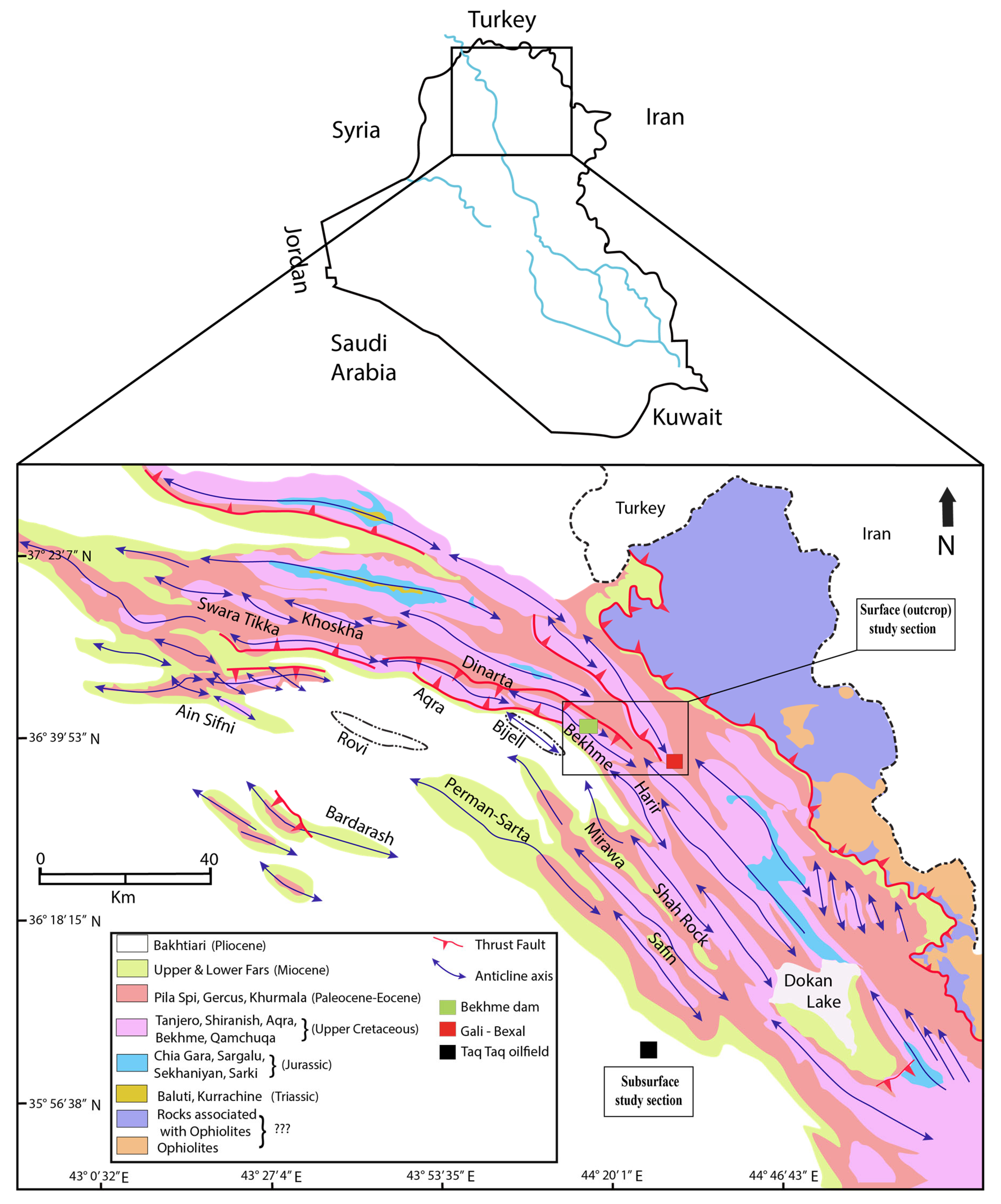
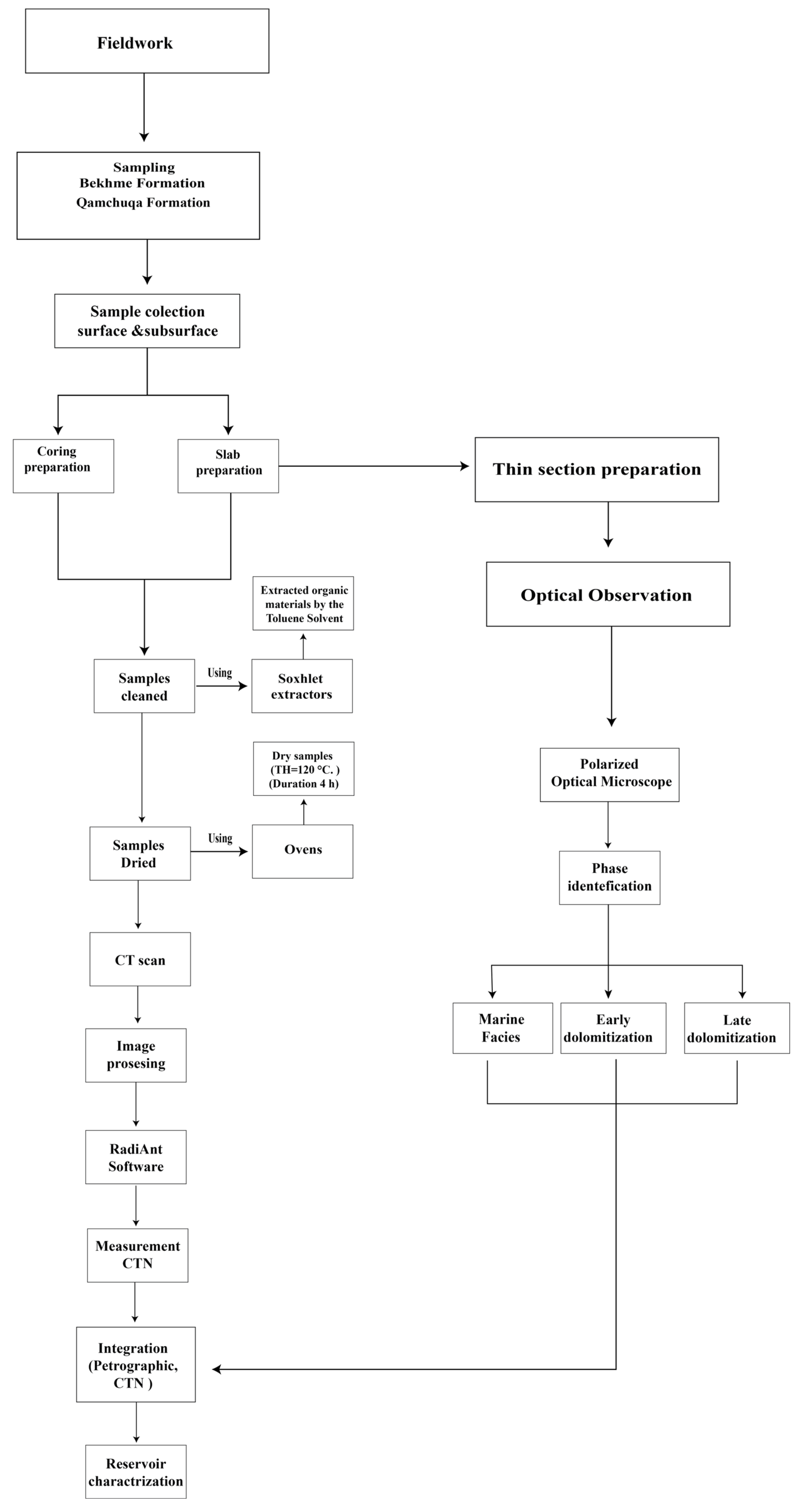


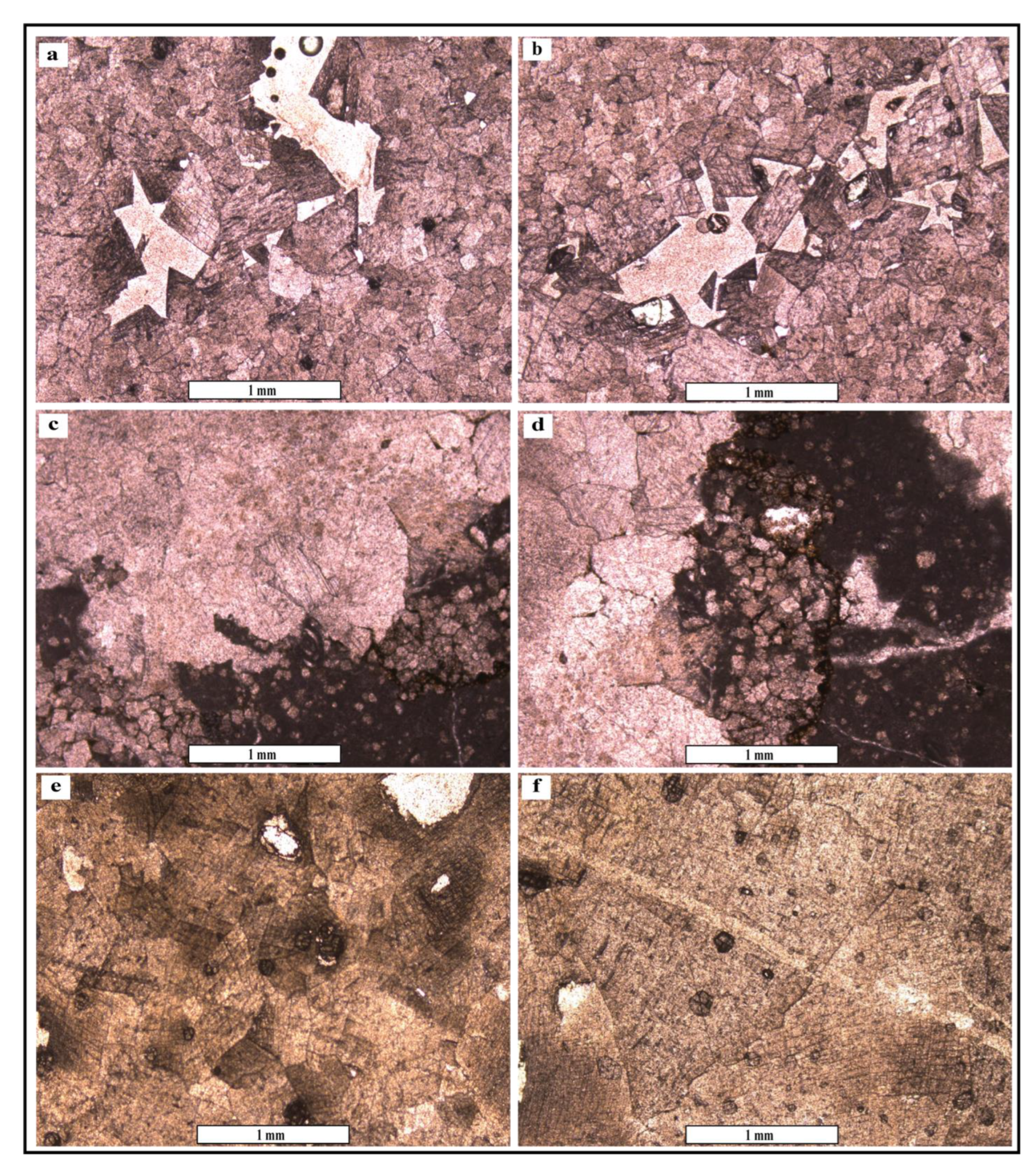
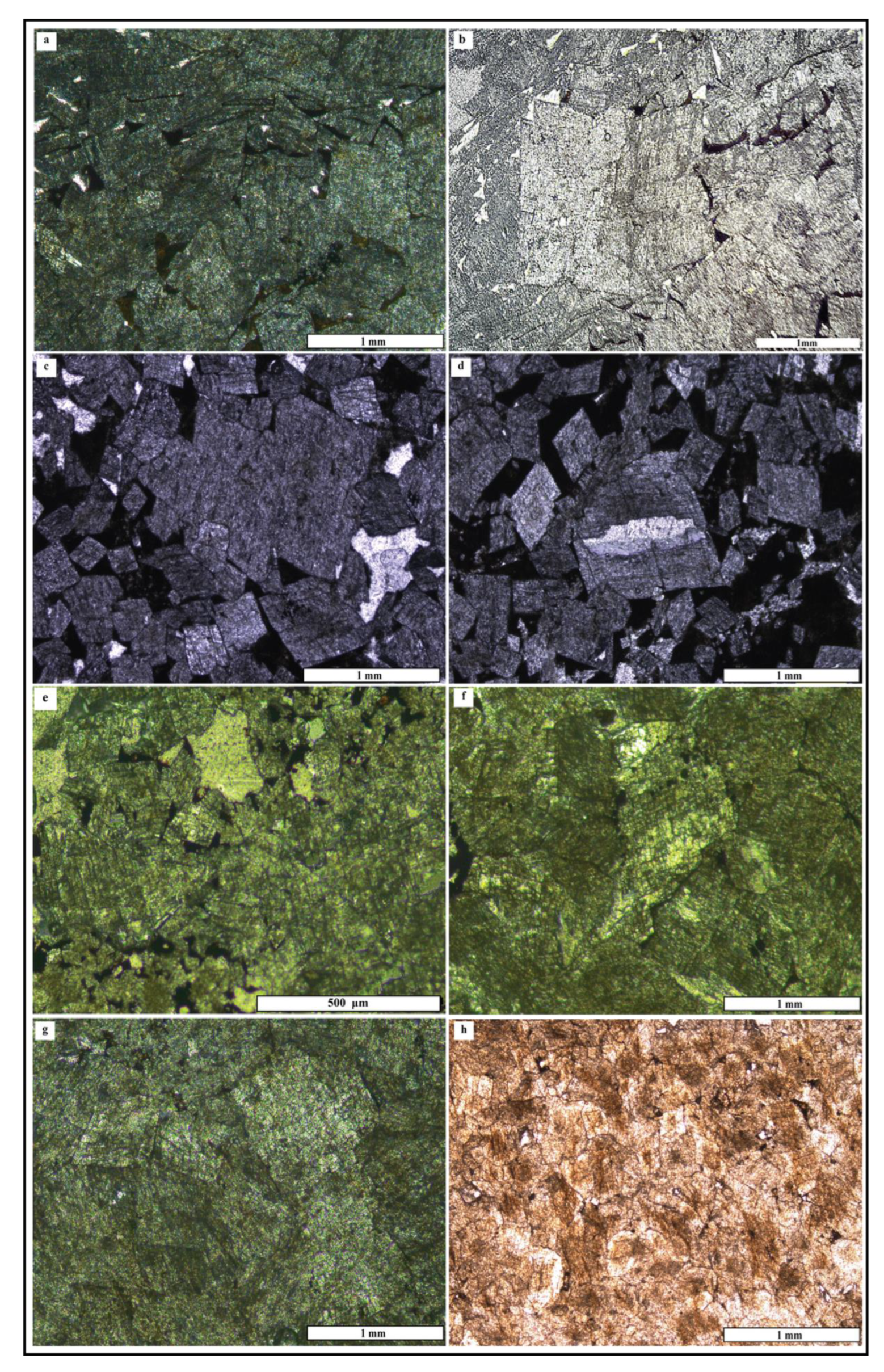
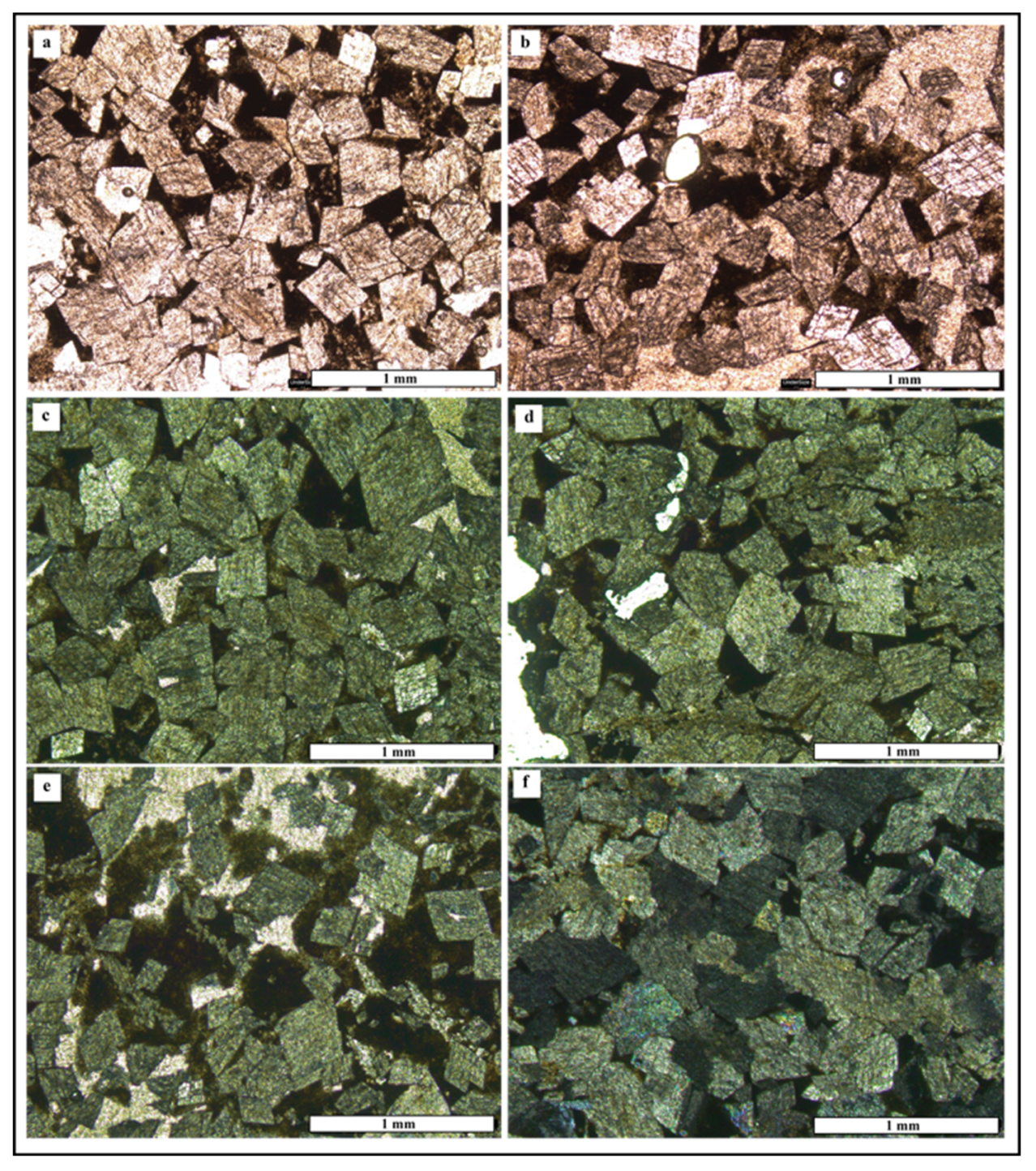
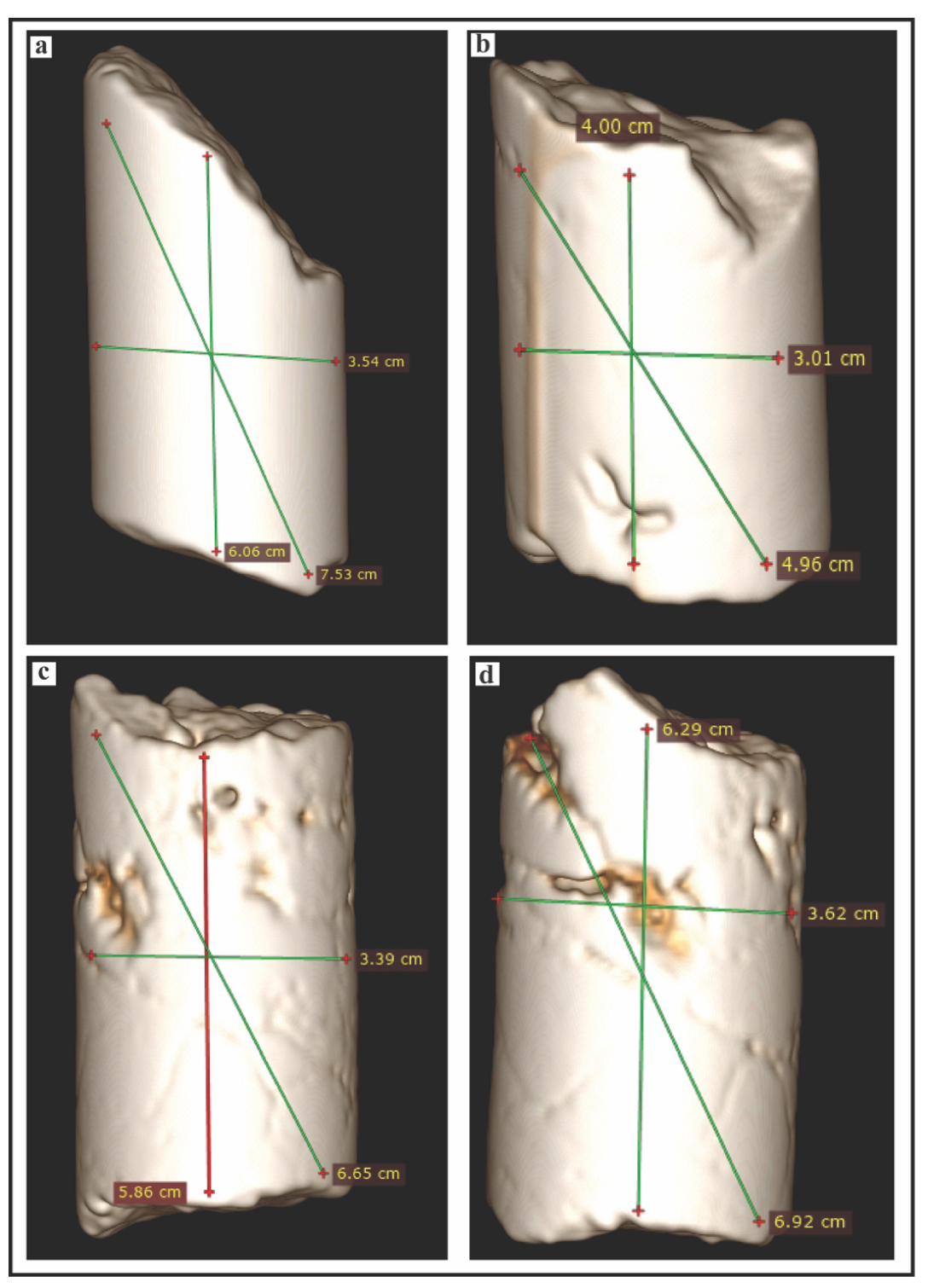
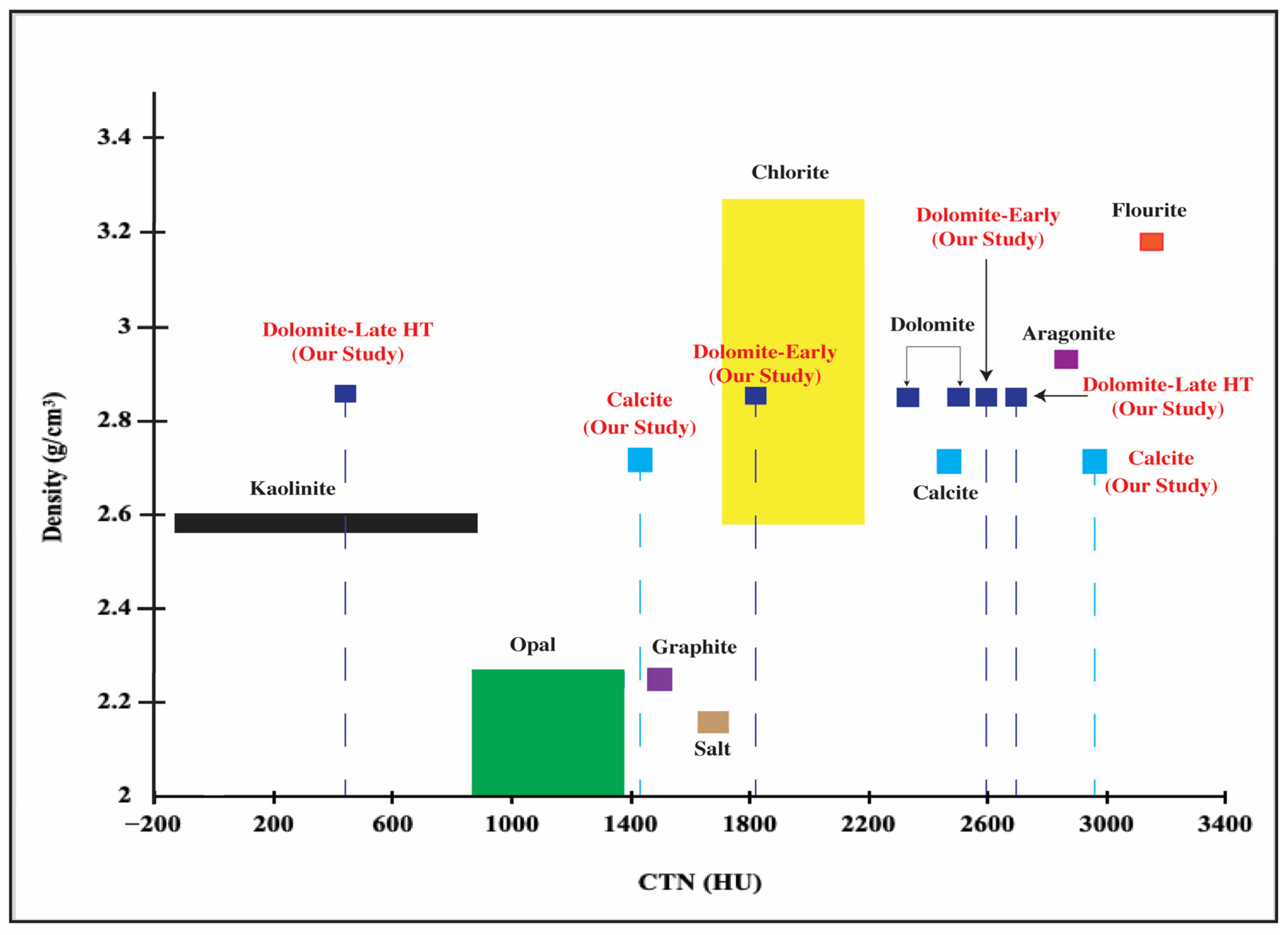
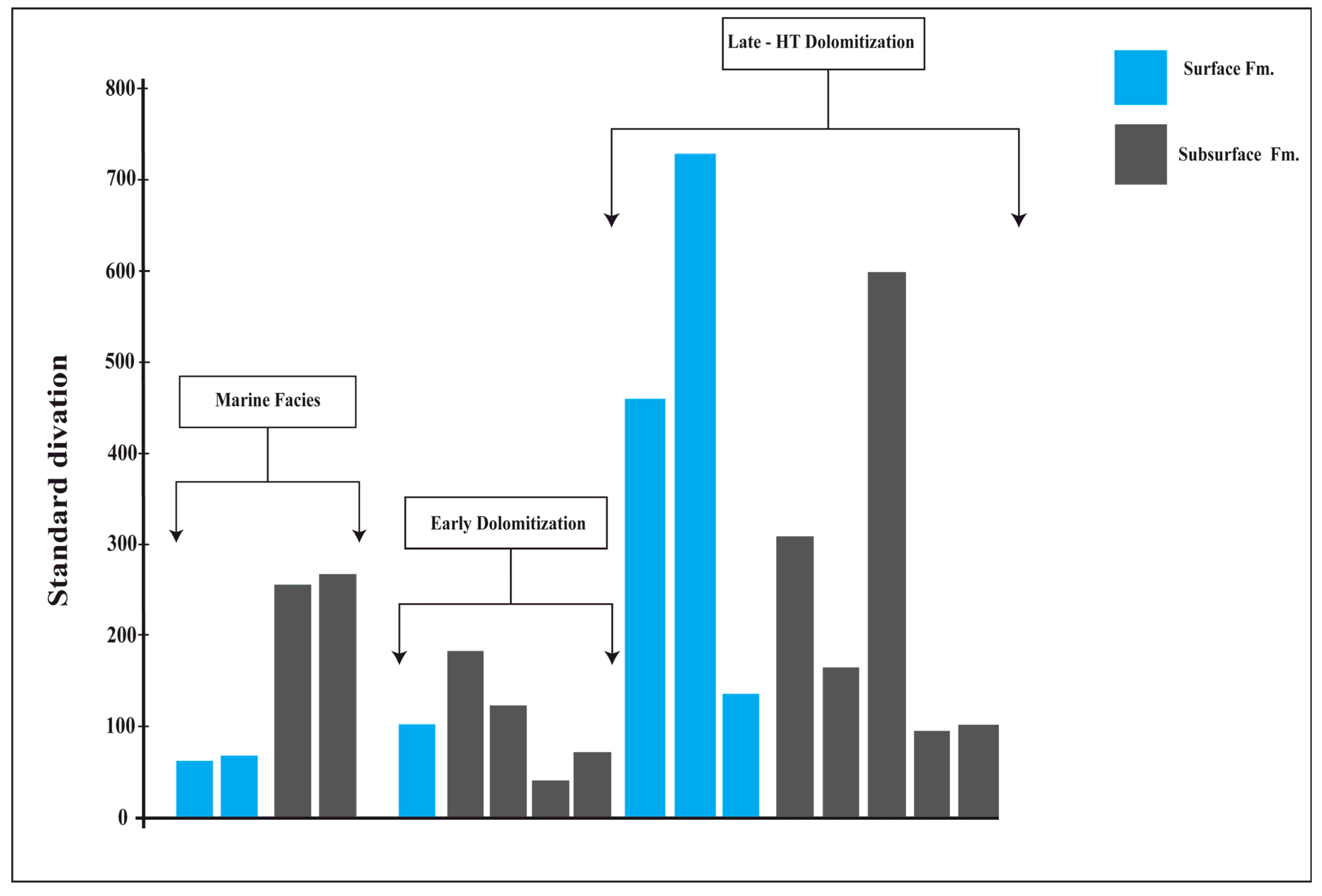
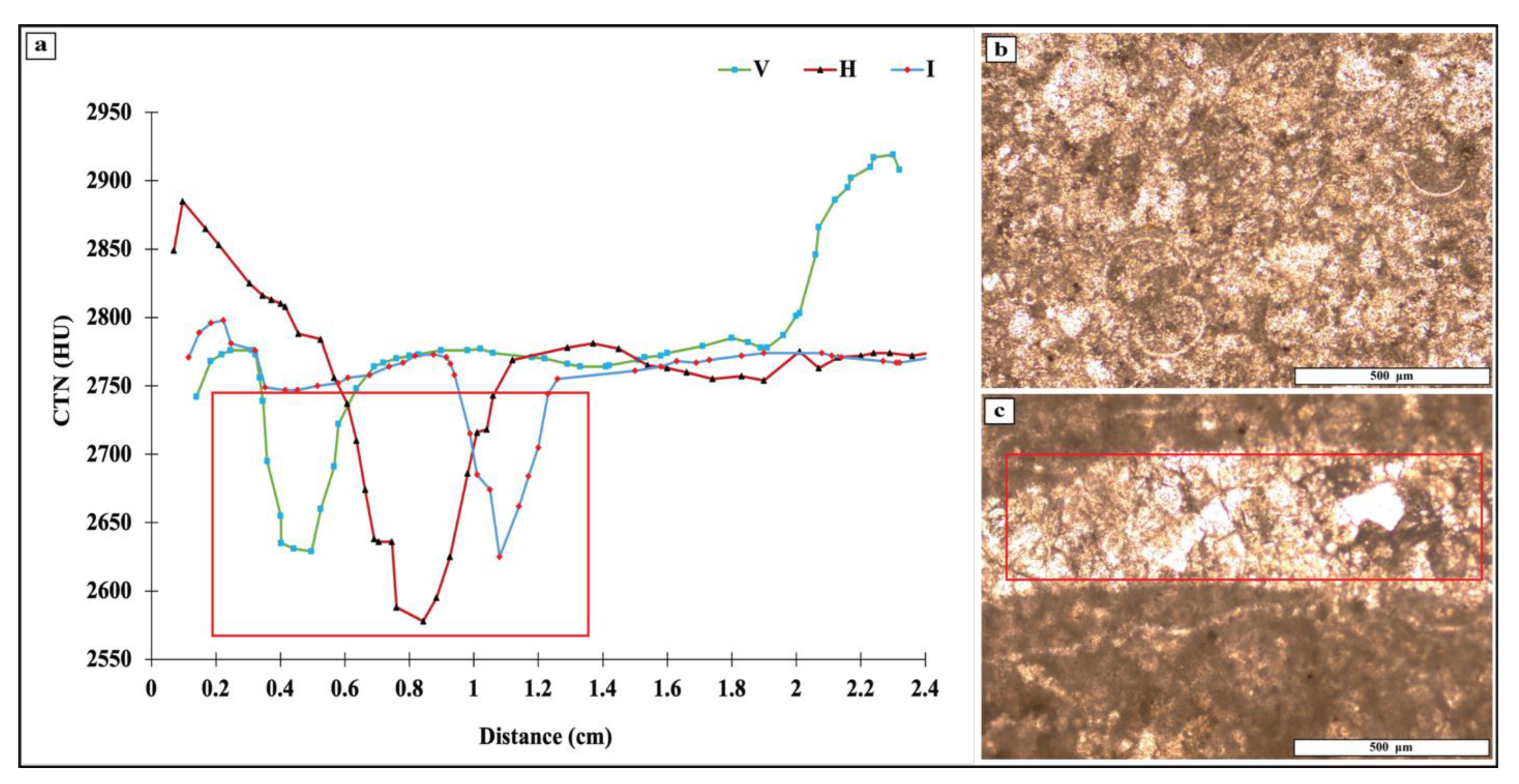
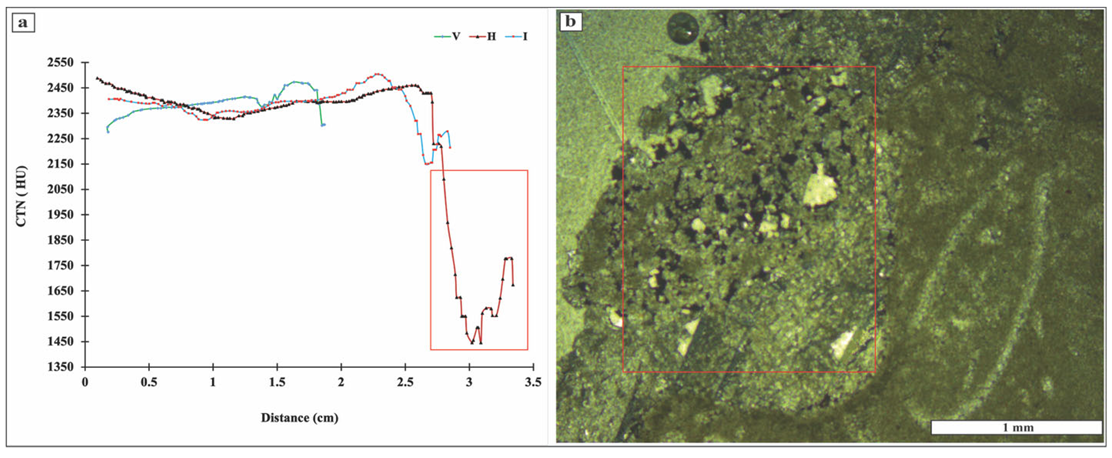

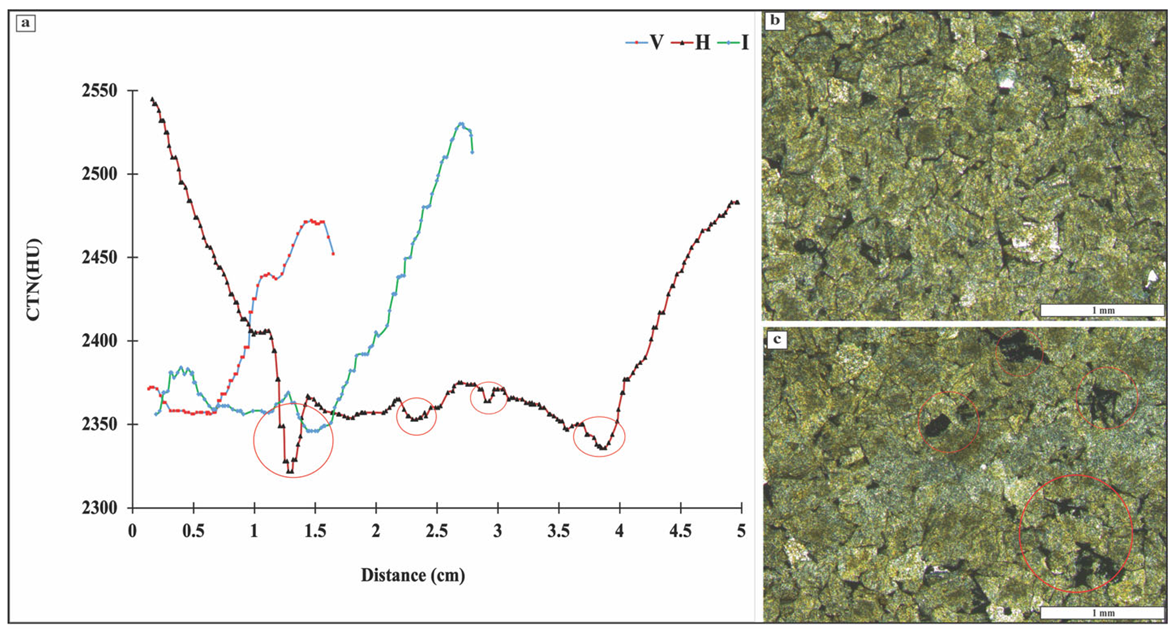
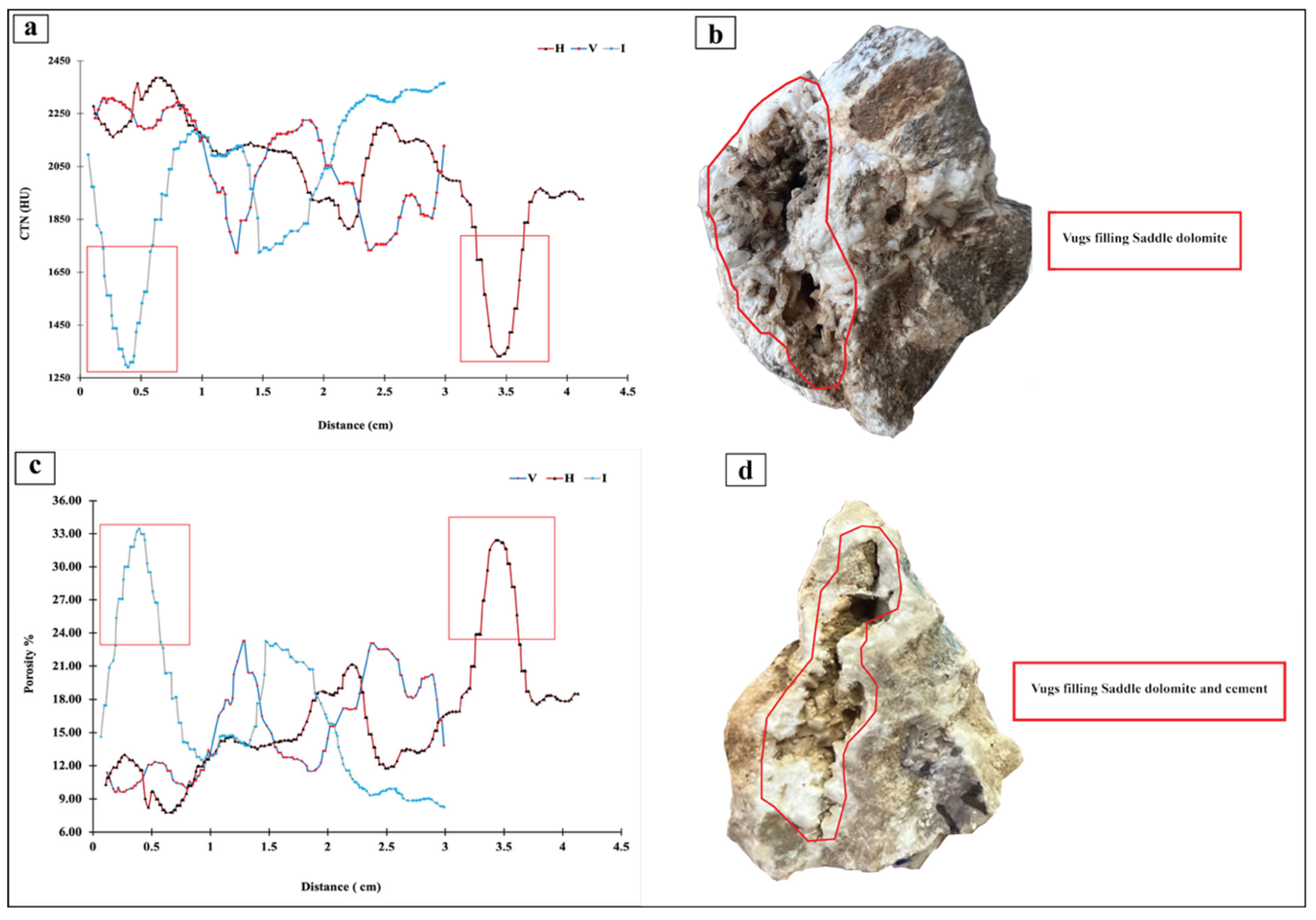
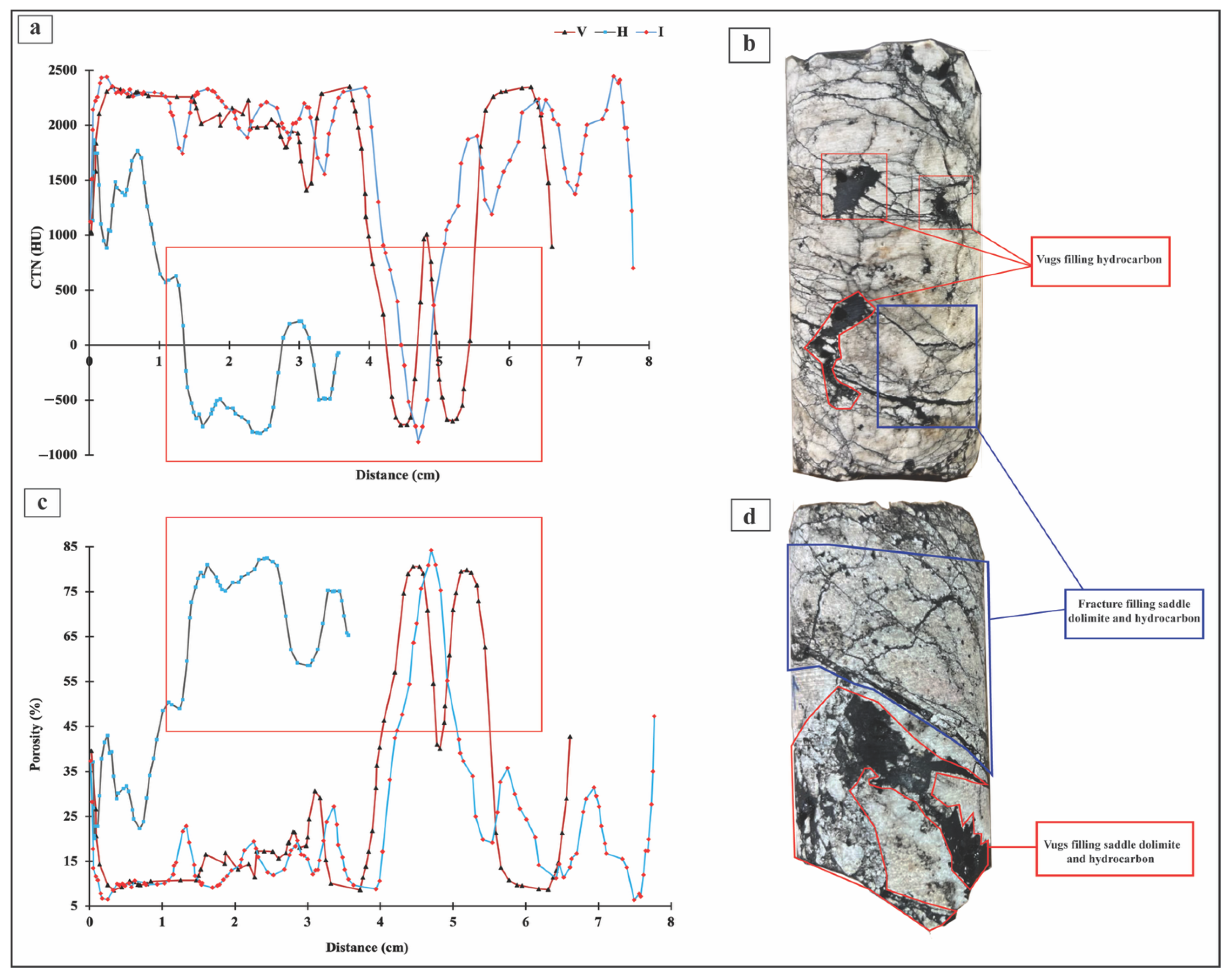

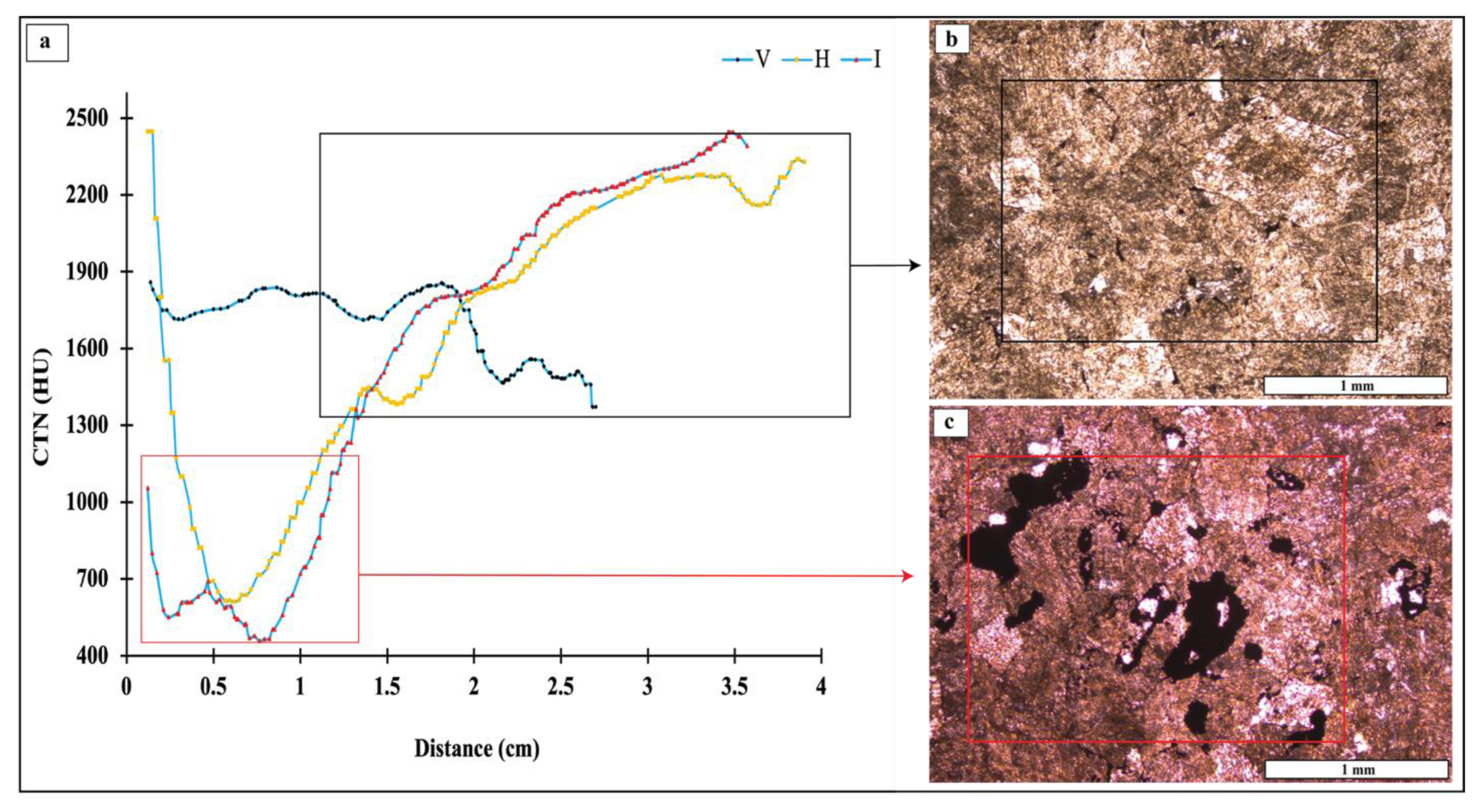
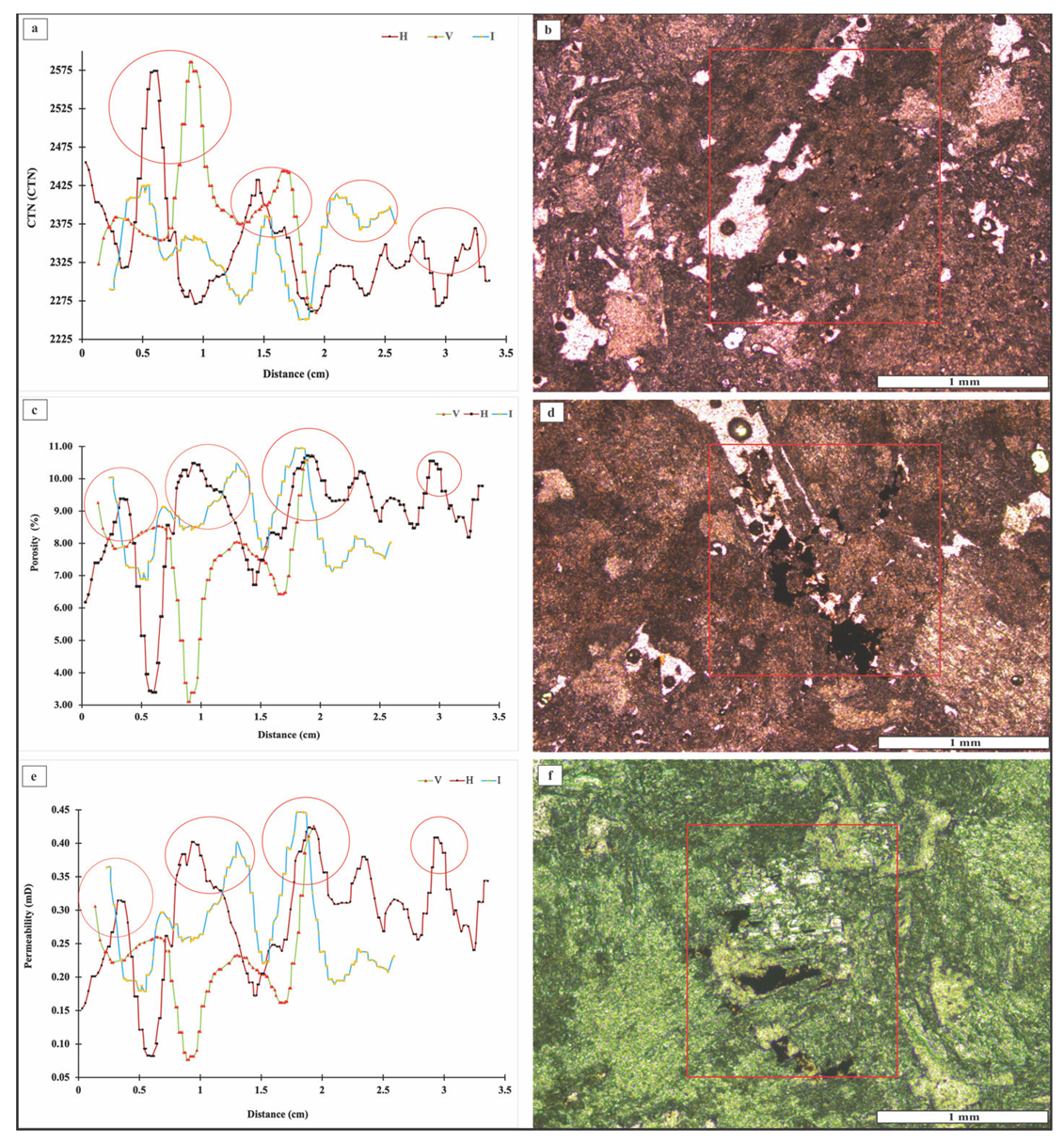
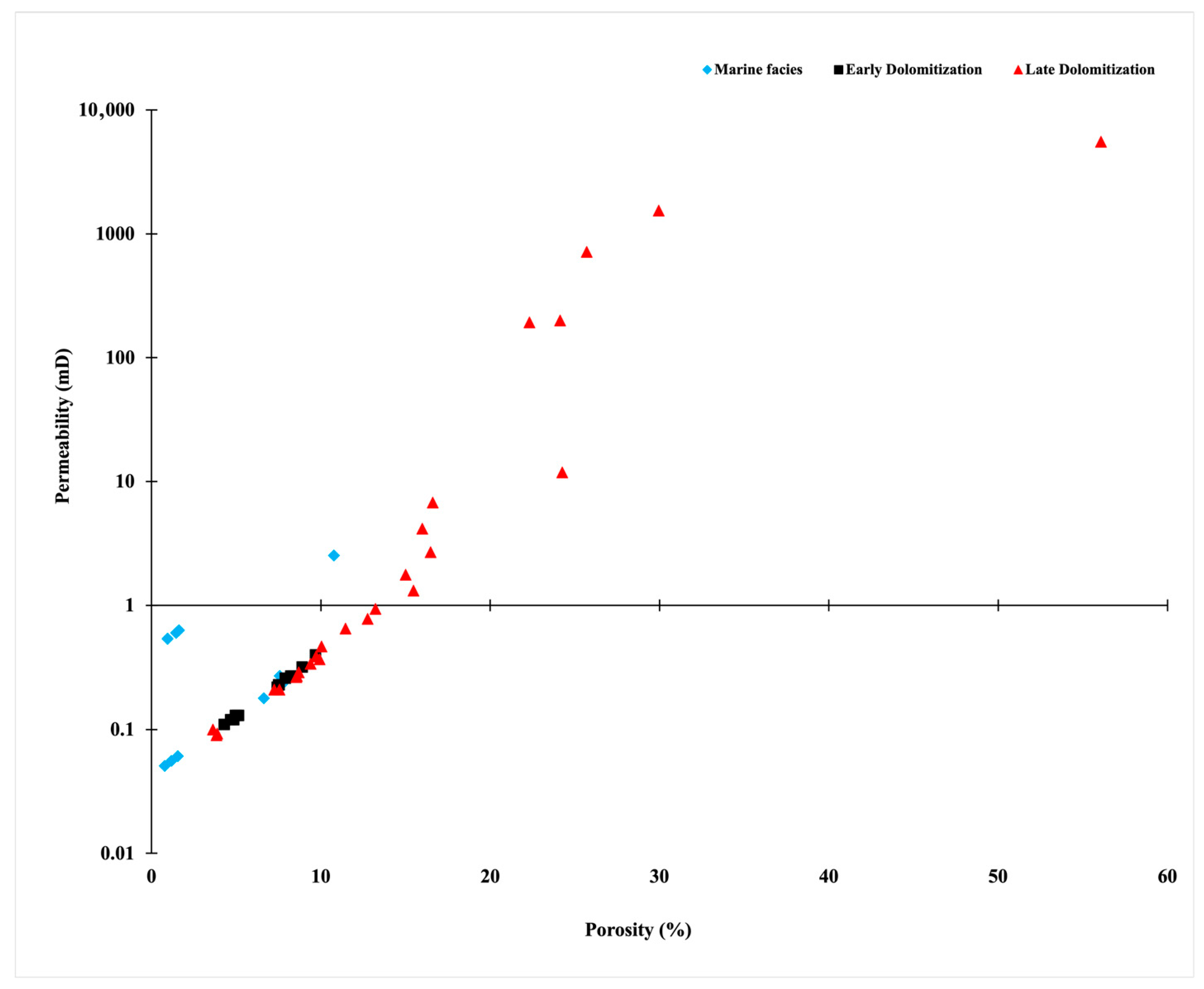
| Sample No. | Sdv | Area | Paragenetic |
|---|---|---|---|
| Surface Reservoir Samples | |||
| Z1 | 63 | 5.16 cm2 | Marine Facies |
| Z17 | 68 | 10.89 cm2 | Marine Facies |
| Z12 | 102 | 9.71 cm2 | Early Diagenesis |
| Z16 | 460 | 7.20 cm2 | Late HT-diagenesis |
| Z22 | 137 | 7.29 cm2 | Late HT-diagenesis |
| Z35 | 725 | 21.12 cm2 | Late HT-diagenesis |
| Subsurface Reservoir Samples | |||
| Q1 | 268 | 3.12 cm2 | Marine Facies |
| Q2 | 252 | 3.26 cm2 | Marine Facies |
| Q3 | 184 | 2.30 cm2 | Early Diagenesis |
| Q4 | 122 | 3.01 cm2 | Early Diagenesis |
| Q5 | 40 | 4.12 cm2 | Early Diagenesis |
| Q6 | 72 | 3.93 cm2 | Early Diagenesis |
| Q7 | 309 | 3.33 cm2 | Late HT-diagenesis |
| Q8 | 167 | 1.21 cm2 | Late HT-diagenesis |
| Q9 | 598 | 9.05 cm2 | Late HT-diagenesis |
| Q10 | 96 | 2.19 cm2 | Late HT-diagenesis |
| Q11 | 102 | 1.83 cm2 | Late HT-diagenesis |
| Paragenetic Sample | NO. Spot Analysis | Min CTN (HU) | Maxi CTN (HU) | CTN (Av) | Porosity (%) | Permeability (mD) |
|---|---|---|---|---|---|---|
| Marine Rock | 389 | 2578 | 2982 | 2740 | 1.20 | 0.14 |
| Early Dolomite rock | 394 | 1840 | 2564 | 2355 | 8.51 | 0.35 |
| Late HTD rock | 1201 | −881 | 2697 | 2058 | 15.47 | 301.27 |
| Paragenetic Sample | NO. Spot Analysis | Min CTN (HU) | Maxi CTN (HU) | CTN (Av) | Porosity (%) | Permeability (mD) |
|---|---|---|---|---|---|---|
| Marine Rock | 414 | 1446 | 2556 | 2360 | 8.40 | 1.02 |
| Early Dolomite rock | 1139 | 2142 | 2619 | 2441 | 6.49 | 0.19 |
| Late HTD rock | 1713 | 457 | 2586 | 2118 | 14.05 | 91.56 |
Disclaimer/Publisher’s Note: The statements, opinions and data contained in all publications are solely those of the individual author(s) and contributor(s) and not of MDPI and/or the editor(s). MDPI and/or the editor(s) disclaim responsibility for any injury to people or property resulting from any ideas, methods, instructions or products referred to in the content. |
© 2025 by the authors. Licensee MDPI, Basel, Switzerland. This article is an open access article distributed under the terms and conditions of the Creative Commons Attribution (CC BY) license (https://creativecommons.org/licenses/by/4.0/).
Share and Cite
Muhammad, Z.; Salih, N.; Préat, A. Evaluation of Hydrocarbon Entrapment Linked to Hydrothermal Fluids and Mapping the Spatial Distribution of Petroleum Systems in the Cretaceous Formation: Implications for the Advanced Exploration and Development of Petroleum Systems in the Kurdistan Region, Iraq. Minerals 2025, 15, 908. https://doi.org/10.3390/min15090908
Muhammad Z, Salih N, Préat A. Evaluation of Hydrocarbon Entrapment Linked to Hydrothermal Fluids and Mapping the Spatial Distribution of Petroleum Systems in the Cretaceous Formation: Implications for the Advanced Exploration and Development of Petroleum Systems in the Kurdistan Region, Iraq. Minerals. 2025; 15(9):908. https://doi.org/10.3390/min15090908
Chicago/Turabian StyleMuhammad, Zana, Namam Salih, and Alain Préat. 2025. "Evaluation of Hydrocarbon Entrapment Linked to Hydrothermal Fluids and Mapping the Spatial Distribution of Petroleum Systems in the Cretaceous Formation: Implications for the Advanced Exploration and Development of Petroleum Systems in the Kurdistan Region, Iraq" Minerals 15, no. 9: 908. https://doi.org/10.3390/min15090908
APA StyleMuhammad, Z., Salih, N., & Préat, A. (2025). Evaluation of Hydrocarbon Entrapment Linked to Hydrothermal Fluids and Mapping the Spatial Distribution of Petroleum Systems in the Cretaceous Formation: Implications for the Advanced Exploration and Development of Petroleum Systems in the Kurdistan Region, Iraq. Minerals, 15(9), 908. https://doi.org/10.3390/min15090908







